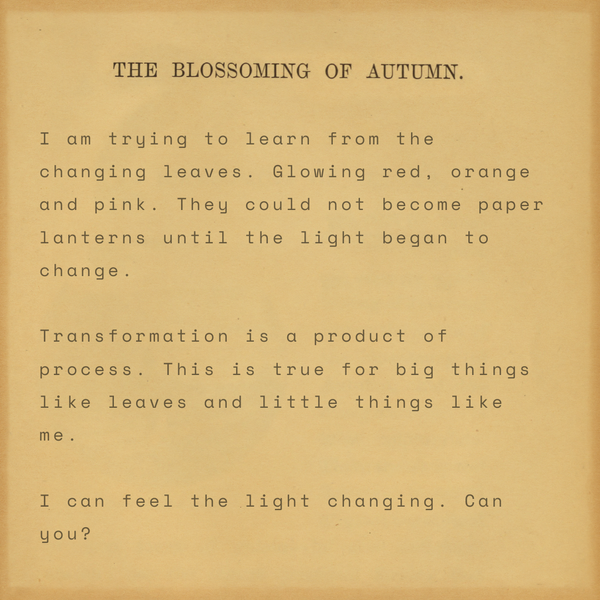Manifest Destiny
Manifestation culture, Christy Dawn and the occult???
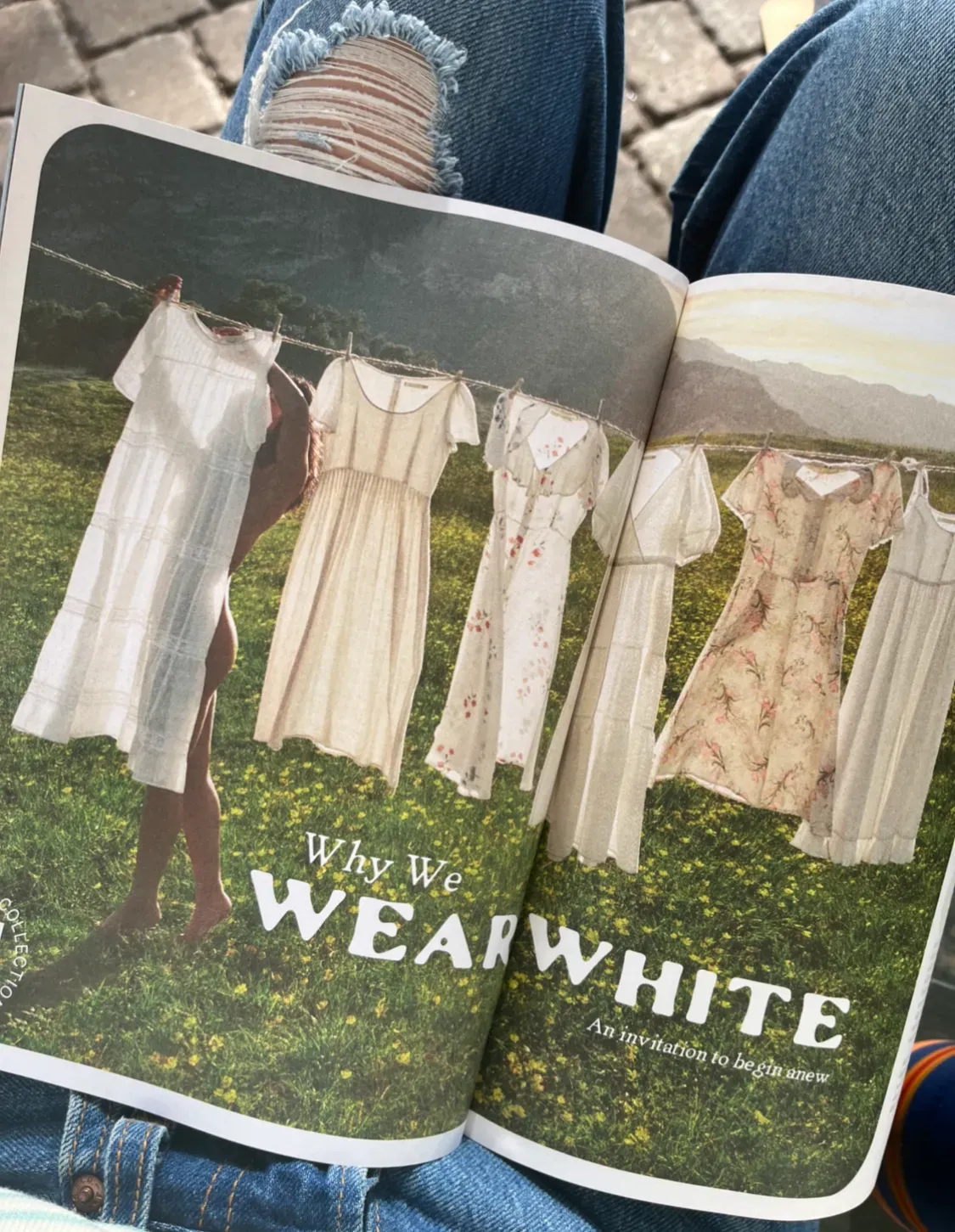
I thought that doing a quick analysis of each page of the latest Christy Dawn catalog seemed like a fun, relatively easy exercise. I don’t know. I guess I imagined it’d just be me making Anne of Green Gable cosplay jokes while also admitting that I very much like to dress like I am in Anne of Green Gables.
As I did my research, the analysis went into wildly unexpected places pretty quickly. Did I expect to include tidbits about a wealthy white British occultist who invented a religion with a eucharist made of honey, kamut, dead yeast cells produced by wine fermentation and semen? No! Not really! And yet that is indeed what we find.
I could write a book about this catalog. Each set of pages could be a chapter analyzing color choices, model poses, photo composition, and cultural context. Instead of a book, I’ve written a three part newsletter series. It’s kind of an experiment. We’ll see how we like it. I think we need to start really interrogating the stories that fill our homes. Even the ones that come in catalogs.
This is written kind of like a letter. Imagine me sitting at my desk, dashing it off because I’ve got to get it out to the mailbox before the post comes.
I don’t spend much time analyzing the dress design because Anne Helen Petersen already did it, and better than I could have, in Unpacking the Nap Dress. Her whole article is amazing, especially the analysis of the Mother Daughter dress in the context of class and race. Read it immediately.
For a long time, mail order catalogs connected people to goods they wouldn’t usually be able to access where they lived. This was especially meaningful for rural Americans. When my grandmother was a little girl, she checked the mail every day in the months leading up to the Christmas shopping season. The annual Sears Wishbook was the highlight of her year. Mail order catalogs were so vital in the 20th century, Americans even order their homes through them.

Now most goods can be ordered online, if you’ve got the money. Because of smartphones, online really means everywhere. There doesn’t seem to be much need for catalogs anymore. But over the past few years, I’ve been getting more and more of them in the mail. Many of the catalogs feel like storyboards from Netflix shows about a white girl finding herself in Europe. There’s so much copy. Like, a paragraph about the taste of a strawberry in a French farmer’s market in a catalog selling jeans. The images are equally…rich. It’s sometimes difficult to sort out which items in the images are products and which are props.
In Harvard Business Review, Jonathan Z. Zhang wrote that catalogs are making a comeback because they work. In a study conducted with a luxury retailer, Zhang found that customers who received email and catalog marketing “experienced a 15% lift in sales and a 27% lift in inquiries, compared to ‘Email-only’ group.” Part of this is because of a thing called the vividness effect. Research has shown that consumers are more likely to order a product if it’s been marketed with vivid language and imagery. The idea is that vividness helps consumers “visualize and imagine” using the product. Catalogs are telling stories with more props than products because they’re trying to increase their vividness effect.
I got a Christy Dawn catalog in the mail the other day. It was shoved in between mailers about refinancing my house and appliance sales. I tossed the ads in the recycle bin but kept the catalog. Partly because it’s nice to pretend the mailbox functions as something other than a spam folder. Partly because I truly do love Christy Dawn dresses.

The dresses are pretty far outside my budget. Christy Dawn says the dresses cost more because they pay their employees a living wage. I’m sure that’s true. Last year, my husband bought two Christy Dawn dresses for me on eBay. The quality is infuriatingly great. When I tried the dresses on, I imagined buying three more and then just making that my entire wardrobe. I’d rotate through five dresses until each one wore out. Economically, environmentally, and ethically, a smaller wardrobe of sustainably made clothes is a much better option than a closet full of fast fashion. But, like most things that are better in the long-term, the short-term cost is high. So I’ve got the two dresses.
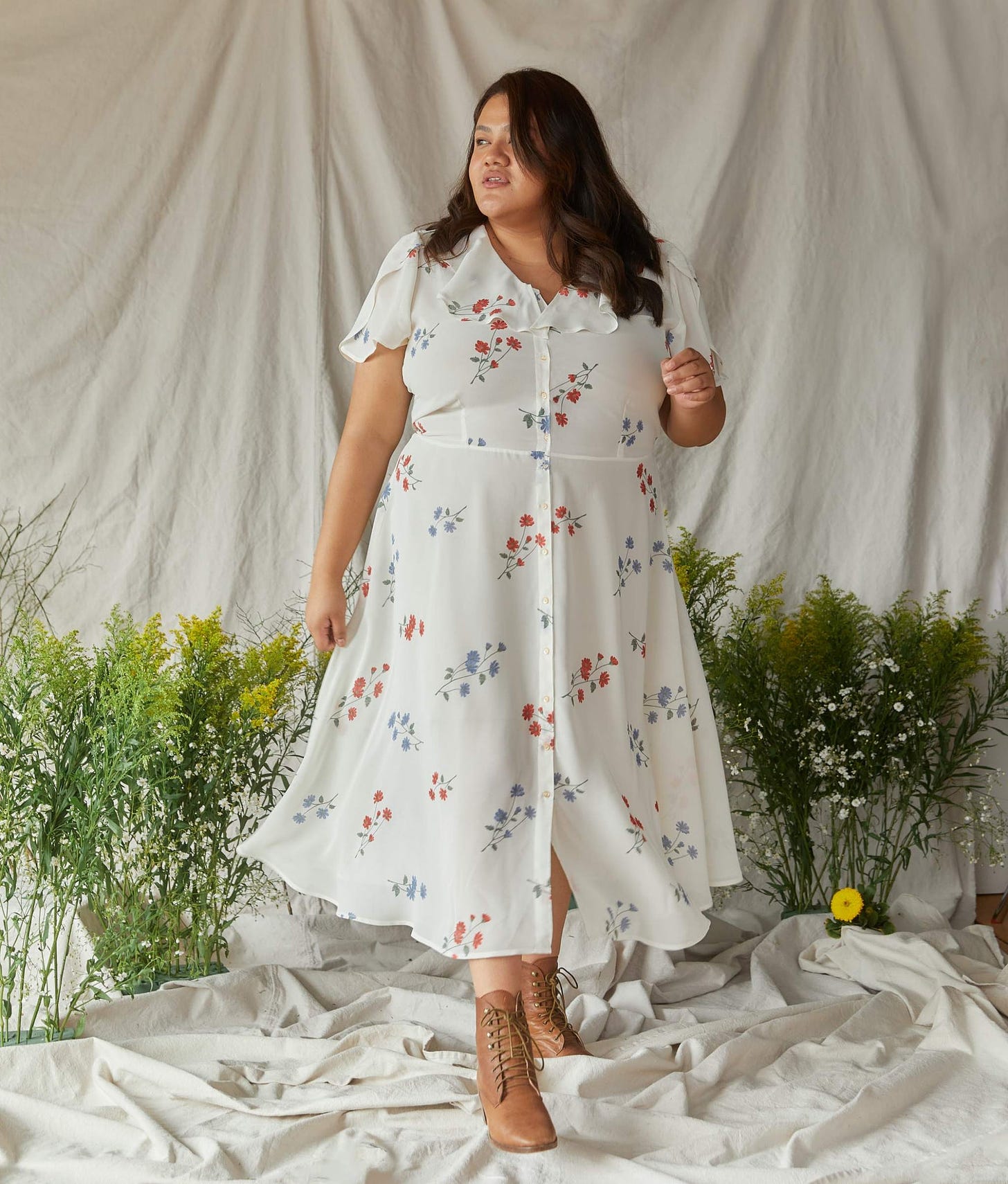
Christy Dawn dresses are kind of like a Rorschach test. When I posted about the dresses on Twitter a few weeks ago, one friend said they reminded her of the evangelical homeschoolers she’d been raised around. Another woman said that they looked like clothes from a “fever dream.” I think they look like a very narrow slice of California. It’s tempting in 2022 to call the Christy Dawn aesthetic something like, Los Angeles Mystic Who Walks Barefoot on Her Reclaimed Wood Floors in Her Topanga Canyon Home. But as a teen, I just called it beautiful.
The Christy Dawn look looks like the women I saw as I wandered through Los Angeles vintage shops. They were all loose dresses, all seventies flow, long hair and long limbs. It also looks like being a teen waiting in the checkout line at the grocery store with my mom. I’d flip through the fashion section of People while I waited for her to pay. If Drew Barrymore was featured, I’d ask if I could have the magazine. I loved her California flower child style. I used to cut out the pictures of her and save them in my desk drawer. They’d help me remember how I wanted to look the next time I had to go school shopping.
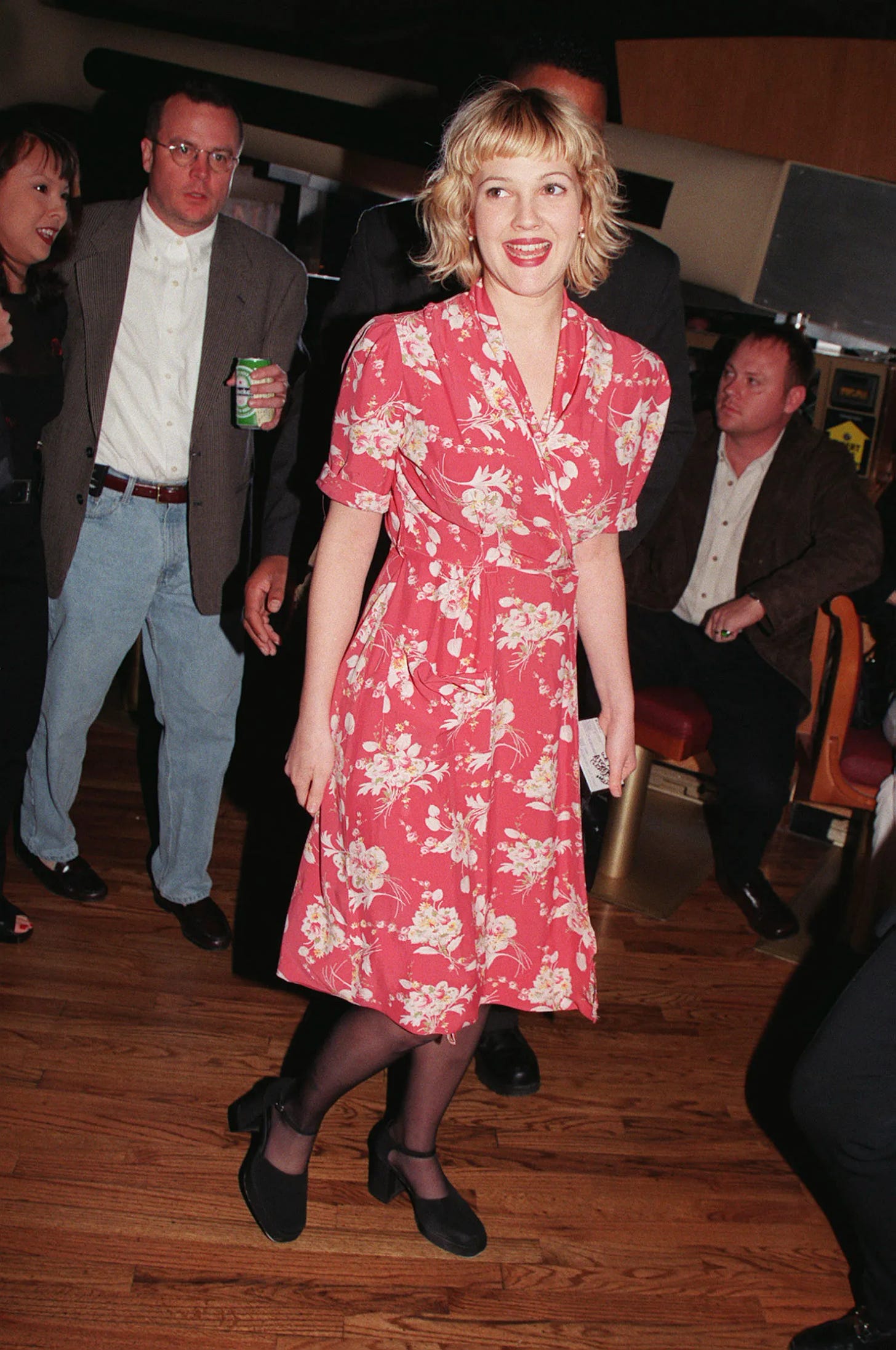
It wasn’t all uncomplicated adoration. I wasn’t long and lithe like the women in the vintage shops. And I wasn’t glowy like Drew. I didn’t realize that the women I saw dress this way were mostly white women moving in white-spaces. But it’s not lost on me now. It’s much easier to dress against trends if everything else is moving your way.
I was a teen in the late 90s and early 2000s, the Age of Britney. It didn’t really matter how much I loved a flowing dress or how many photos of Drew I saved. I couldn’t figure out how to wear 1970s does Little House on the Prairie dresses to high school. Instead, I wore what the stores in the mall were selling. Low-rise jeans and little cropped shirts. I did not have Hollister mannequin dimensions. At school, I learned to perch on the edge of my seat with my back slightly leaned back to keep my big ass inside those low waistbands. I lived in the California suburbs. I thought maybe soft dresses were a hippy dippy Los Angeles thing.
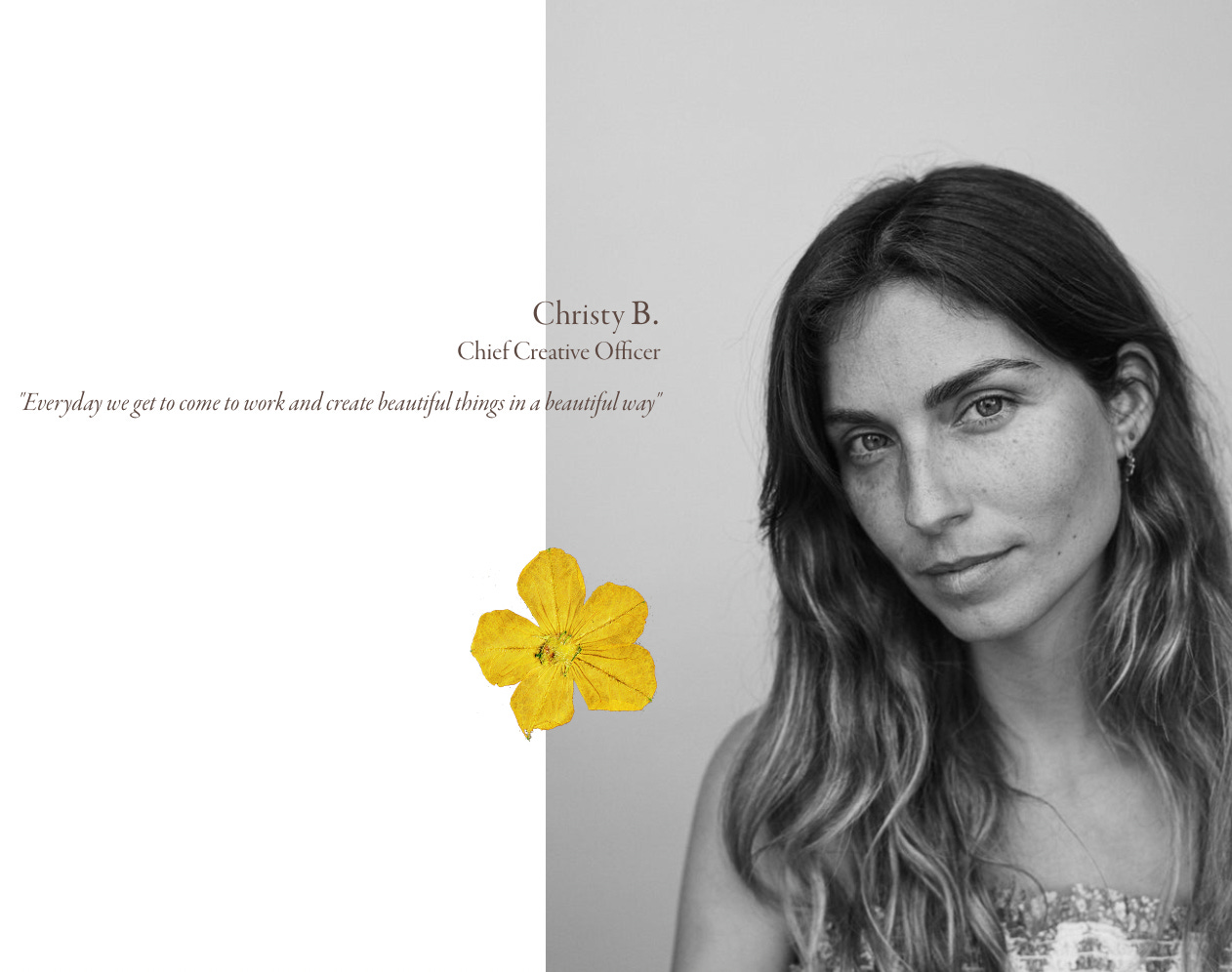
Christy Dawn feels like that narriow slice of California because it comes from it. The company was started in 2014 by Christy and Aras Baskauskas. Christy was raised in Placerville, a little mountain town between Sacramento and Lake Tahoe. Levi Strauss got his start in Placerville, and Northern California towns like it. Thomas Kinkade is also from Placerville. In interviews, Christy sounds like that friend who tells you everything will be okay while making you a very good cup of tea. Christy says she was raised on ten acres, with chickens and horses. She left that idyll to become a model in Los Angeles. She’s got the California story that I knew I’d never be pretty enough to live: Fresh faced girl moves to Los Angeles to become a model.

Aras was raised in Santa Monica. You might know him from the time he won Survivor. What is much harder to find online is the fact he’s the grandson of Hollywood royalty. His grandpa was Macdonald Carey. Carey was a B-movie star, he was called the “King of the Bs”. He reigned with Lucille Ball, the Queen of the Bs. He also played Tim Horton on Days of Our Lives for over three decades. Carey’s voice narrates the beginning of the soap, "Like sands through the hourglass, so are the Days of Our Lives.” Apparently, little Aras even got to be on TV for a Days of Our Lives Christmas special. I think that’s adorable.

I’ve read and listened to several interviews where Aras talks about Christy Dawn. I haven’t heard him mention his grandfather. He often implies he doesn’t come from money or connected places. He’s not really alone in this. The children and grandchildren of Hollywood elites often feel they lack wealth and connections. I once met the grandchild of a successful movie star. While explaining how down to earth she was, she claimed she’d never gotten any help from her family connections. Well, no help except prep school tuition, college tuition, and a “very small trust that was only big enough to like buy a house, maybe.” And that was just the help she acknowledged. When you grow up adjacent to hundred-millionaires, a lot can feel like a lack, I guess. It’s possible, of course, that Aras never had access to his grandfather’s money. But in Los Angeles, and pretty much everywhere else, connections are currency.
Christy and Aras are very into manifestation. In 2019, they were interviewed by Lacy Phillips for her podcast, Expanded. Phillips runs a manifestation empire from her platform, To Be Magnetic. She’s got hundreds of thousands of followers on Instagram. Mostly, her Instagram is a place to spread the word about her To Be Magnetic workshops. The workshops teach TBM’s “manifestation process backed by neuroscience, psychology, epigenetics, and energetics - with a little spirituality sprinkled in too.”

Phillips says the Universe (always capital U on Universe in these circles) gives things to people who have high “self-worth.” Her workshops are supposed to rewire and reprogram the low self-worth individual into a high self-worth individual. According to this excellent Vice piece by Rose Truesdale, Phillips made at least $580,000 in year-long workshop subscriptions in 2021. That’s 18,000 subs at $324 a year. Truesdale notes those numbers didn’t include that year’s Black Friday sale. I imagine there were a lot of pandemic-exhausted, hope-stripped people shopping that sale. Maybe, just maybe, Phillips would help them become worthy of a better life.
I guess in Phillips’ Universe, Aras and Christy are high worth individuals. In the Expanded interview, Aras and Christy talk about manifesting their home in an exclusive LA neighborhood and the success of their dress business. Christy also talks about manifesting her relationship with Aras. The couple’s devotion to manifestation is crucial to understanding the life the Christy Dawn catalog is calling in.
Manifestation claims you can change your material life with your interior work. You want a house? Manifest it. You want love? Manifest it. You want to be cured of cancer? Manifest it. Everything is yours for the having, you just have to be worthy to call it in. It’s easy to caricature the current iteration of manifestation. There’s lots of influencers in wide brimmed hats. I’m not interested in caricatures, so I wanted to talk to someone who’d experienced the manifesting space as a seeker.
Many influencers were beginning to present manifestation as a kind of research-based spiritual self-therapy.
In 2017, Paige Willey, a software developer and writer, was having a very hard time. Beset by significant health and career problems, she just couldn’t seem to catch her breath. She said she first looked into manifestation because, “When you are desperate you start looking for what you might have missed.” Manifestation wasn’t all astrology signs and vibes. Many influencers were beginning to present manifestation as a kind of research-based spiritual self-therapy. Willey hoped to find a way to help herself move forward while also finding peace. Instead, she found an “alternative prosperity gospel.”
The mainstream Christian prosperity gospel has many iterations but the basics are pretty much the same: God wants you to be rich, you just have to have enough faith to let God make you rich. Manifestation has the same general conceit, it’s just the Universe instead of God. The Universe wants you to have everything you want, you just have to become aligned with the Universe so you can receive it.
The first thing Willey learned as she got into manifestation is that, “everything is between the Universe and you. If manifestation isn’t working, you need to work it out with the Universe.” People pay for workshops from Phillips and others to learn how to work it out.
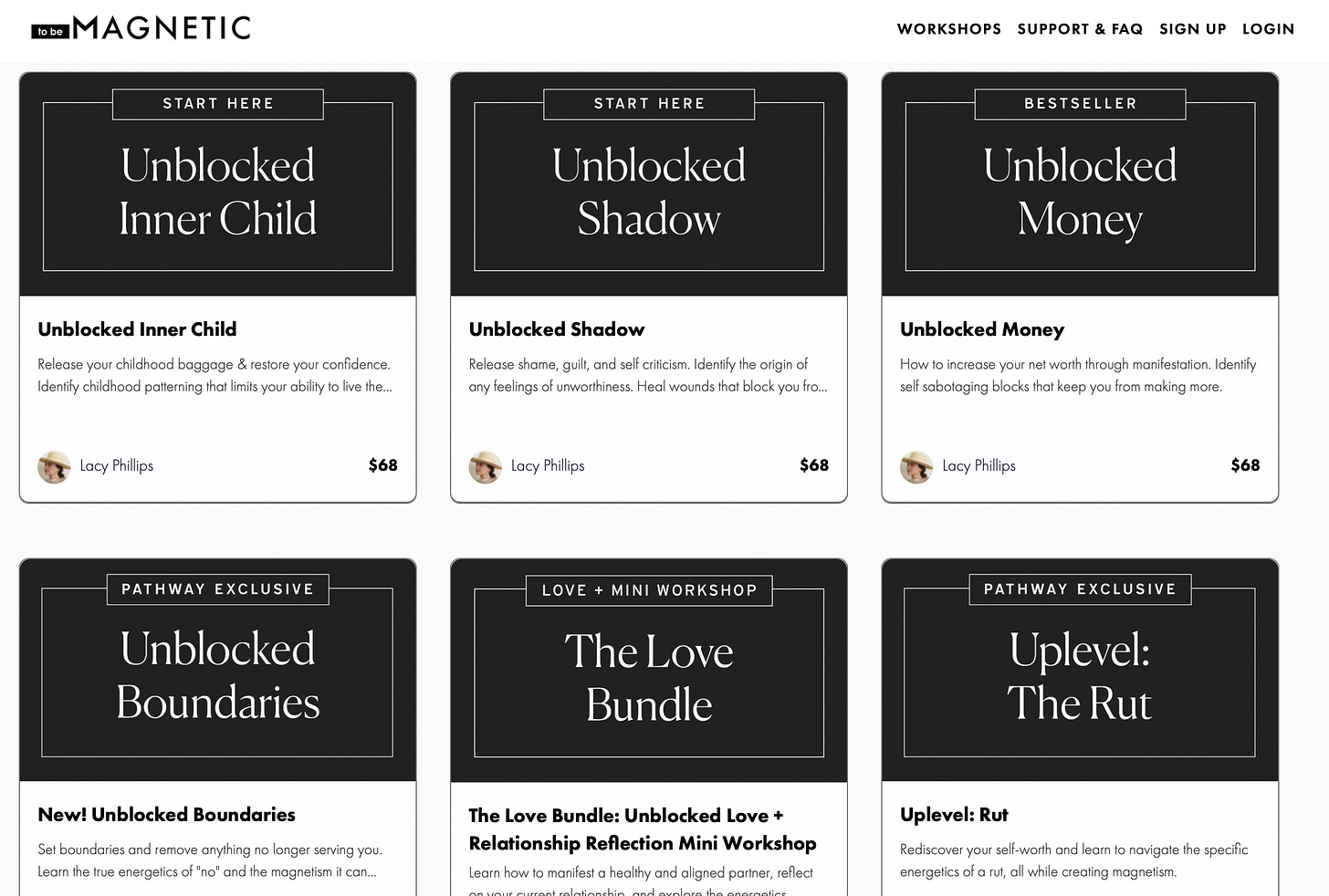
The Christian and Manifestation prosperity gospels focus on the individual’s responsibility for their own success because they come from the 19th century New Thought movement. New Thought beliefs varied but generally they held there was some sort of higher being, innate human divinity, and that mental states create material circumstances. Since a person could manifest wealth and health with their mind, poverty or sickness was proof they weren’t thinking correctly. New Thought adherents claimed to be influenced by the Bible, Hinduism, Transcendentalism and evolution. (19th century white elites were big on appropriating Indian belief systems while exploiting India and its people through colonization. Kind of like 20th and 21st century white elites.)
Ralph Waldo Emerson was very into New Thought. We’ll come back to him later in the series. William James is often called the “Father of American Psychology.” He was also a philosopher and stalwart of the New Thought movement. James came of age before slavery ended and lived during Reconstruction and Jim Crow. But his work never really addressed white supremacy. If you believe the only system is the Universe and everything else is individual, it’s impossible to interrogate and alleviate man-made systemic injustice. Instead, you fundamentally believe everyone is getting exactly what the Universe knows they deserve. So. That’s gross.
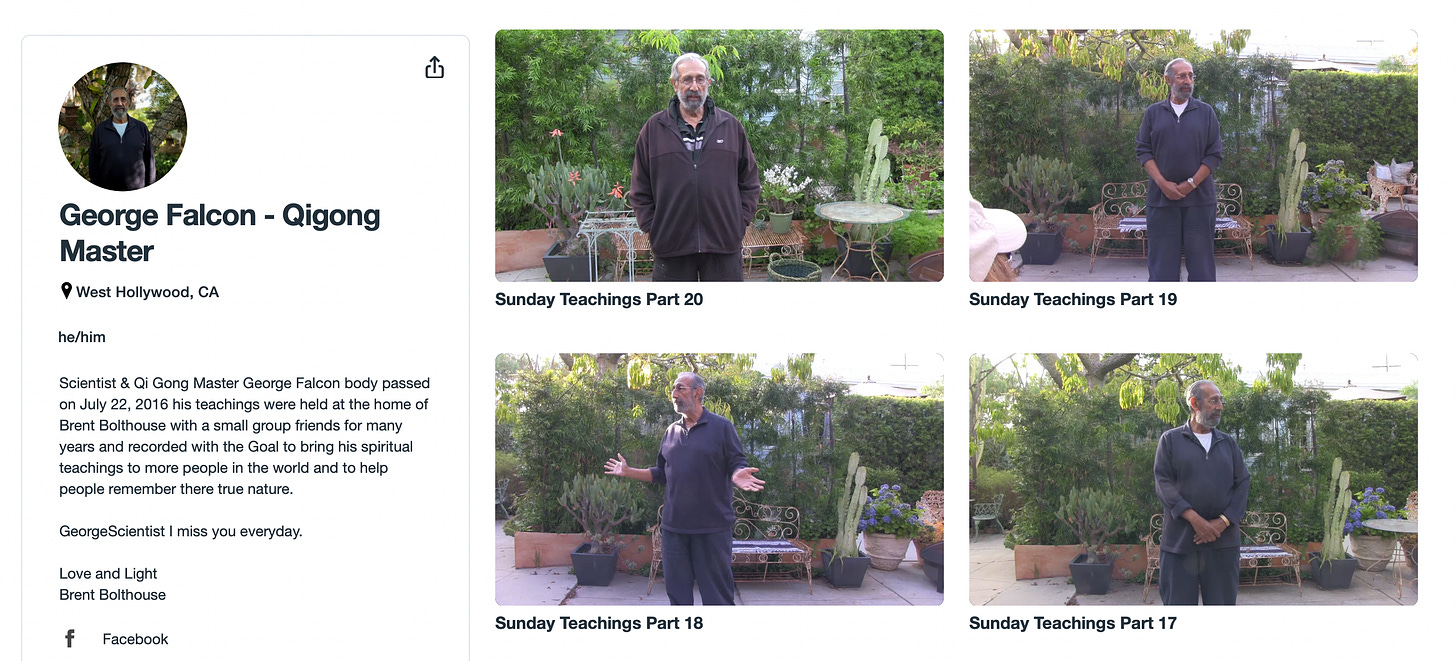
During their interview with Phillips, Christy and Aras talked about their first spiritual teacher, George Falcon. Christy said they’d often go to Falcon because they were ready to break up. George would tell them to stay together, because they’d just have to work on the same thing with someone else if they didn’t. That’s not advice I would give, but I guess I wasn’t there. Falcon died sometime in 2017. It’s hard to find information on this guy. There’s a filmed series of lectures he gave at Brent Bolthouse’s house. Yeah, the guy behind Neon Carnival. In the video descriptions, George Falcon is described as a scientist and Qigong master.

In an interview on the Christy Dawn website, Maria Villella said Christy encouraged her and her husband to start learning from Falcon. She said that she relates to Christy deeply now, partly because of the fact they “have that same voice in our heads, George Falcon saying, ‘Right here, right now, you are free.’” If I’m reading those seven words alone, I can appreciate them. It’s demoralizing to feel owned and manipulated by circumstance and systems. We need to find what freedom we can. And it’s totally possible that’s exactly how Villella interprets of those seven words. But it’s not clear that’s what they meant to Falcon. Right here, right now, you are free becomes a kind of malicious incantation within the context of one of the stories I found about Falcon’s teaching methods.
The story is in a tribute to Falcon on Medium written by one of his students, an artist named Loren Kantor. Kantor writes about being at a LA restaurant with George. A couple started to scream at one another a few tables over. George said it was “a good time to practice peace.” He asked Kantor, “What are some things we can do right now to help this couple?”
I might have said, “Pull the woman aside and ask if she needs help.” Or “Send over a plate of mozzarella sticks.” (You’d have to stop screaming to eat the sticks while they were still piping hot because mozz sticks are disgusting as soon as they cool.The fight would then be solved because you can’t be mad after eating fried cheese! Peace in our time!)
I guess it wasn’t the kind of restaurant that served fried cheese. Instead, Kantor offered to pray for the couple, ask God to pray for them or simply visualize them in light. George told Kantor that each of those options was wrong because they focused on the couple. He said Kantor should focus on himself. George told Kantor to close his eyes and do breathing exercises. After a while, George told Kantor to open his eyes.
When he did, Kantor felt peaceful and saw that the couple was gone. He interpreted this as a profound proof of his ability to manifest peace. He wrote, “As I returned to “reality,” my outer life resembled my inner tranquility. I recalled a quote attributed to Martin Luther King. ‘Be the peace you wish to see in the world.’”
I really wish people would stop quoting Dr. King to maintain their own comfort. Dr. King certainly didn’t mean we were supposed to blip people in distress because they were upsetting our dinner date.
Because the individual and the Universe are all that matter in manifestation, people and the systems that harm them can be removed from a curated reality.
George didn’t actually help his students blip that couple. Instead, he’d taught Kantor how to reach a place inside of himself where he could no longer hear their screams. George knew the couple left before he instructed Kantor to open his eyes. What if they’d stayed? How long would Kantor have kept his eyes closed? When Kantor opened his eyes, he didn’t wonder if the woman was safe with a man who’d scream at her in a restaurant. Instead, he felt he’d achieved peace because they were gone.
Because the individual and the Universe are all that matter in manifestation, people and the systems that harm them can be removed from a curated reality. Right now here, right now, you are free.
Black women in America aren’t more likely to die during pregnancy because they aren’t manifesting health.
After trying a few different manifestation disciplines, Paige Willey walked away from manifestation. Her disillusionment with the movement mostly came down to her understanding of systemic injustice. People in America aren’t poor because they’re not worthy of the universe. They’re poor because they live in an economic system that requires some people to be poor. Black women in America aren’t more likely to die during pregnancy because they aren’t manifesting health. They’re killed by systemic racism in American healthcare.
Figuring out how to become worthy of the Universe sounds like an insurmountable task. But that imagined quest is nothing compared to the reality of surviving in America as a single mother. Systems aren’t controlled by one all knowing entity, they’re composed of many individuals over many years making many decisions. It’s the overwhelming nature of systemic issues that makes so many people open to manifestation. Desperate people look for what they might have missed.

The Christy Dawn catalog calls itself “a journal.” Journaling is a very big thing in manifestation. People who want to manifest homes, relationships, and success are encouraged to journal about their desires every single day. In her interview on Expanded, Christy talked about how Aras was in and out during the first years of their relationship. When Aras left to film his second Survivor appearance, she journaled every day to manifest her relationship with him. When he got home, he told her he was ready to devote himself to the relationship and wanted to have a baby with her. Phillips hmmmm’d in understanding. Christy practiced manifestation, became worthy of the Universe, and got what she’d called in.
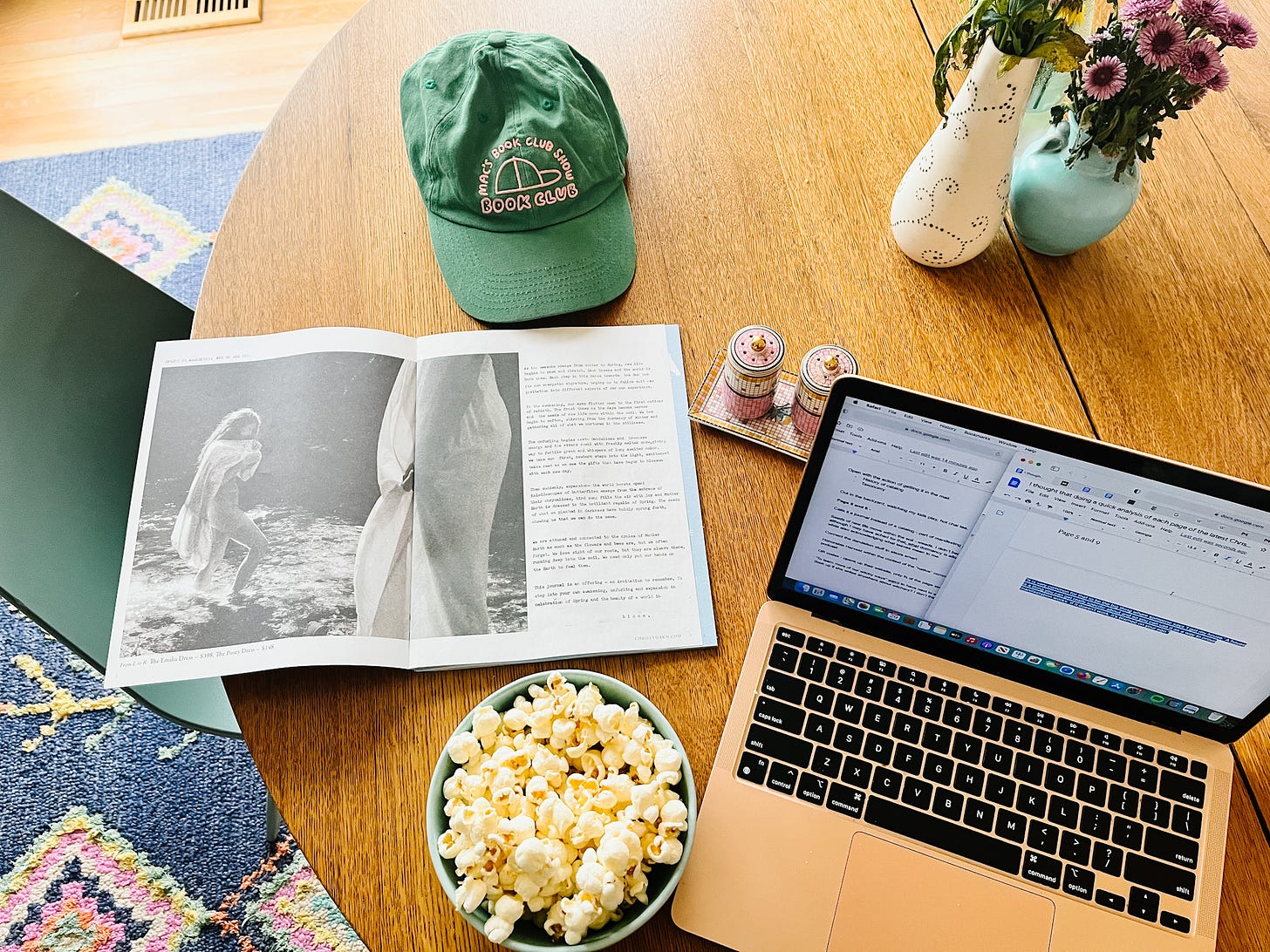
Like many prestige brand catalogs, the Christy Dawn catalog is incredibly vivid. And I mean, now that I think about it, the vividness effect is kind of weirdly related to all this discussion about manifestation and material goods. Catalogs use vividness in their marketing because they want consumers to imagine the product in their lives. Companies hope that imagining will result in the customer ordering - or ummm, calling in - the product. The vividness effect is used to turn thoughts into material reality. That’s different than thinking of a house and the Universe deciding you’re worthy enough to have one. But it does show that our thoughts help construct our material reality. And that other people can manipulate what kind of thoughts we have. Which means that while manifestation can’t call in material goods, its culture can materially hurt us.

Because of that, I think it’s worth taking the time to understand what exactly the Spring 2022 Christy Dawn Journal is calling into our homes.
Want a sneak peek? It includes but isn’t limited to: white supremacy, colonialism, vital Indigenous knowledge, early 20th century eugenics, 19th century British occultists but not the cool kind, economic justice, a perfect stretch of California coast, European folkways, psychoactive compounds, incest, a much-needed revival of traditional textile techniques, old-fashioned classism, meaningful spiritual practice and one dress I really want, if I am being totally honest.



